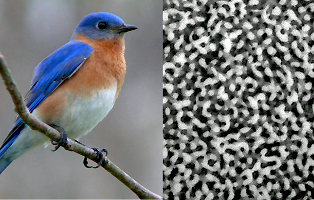Home > Press > Bird Feathers Produce Color Through Structure Similar to Beer Foam
 |
| Prum and Dufresne discovered that the nanostructures that produce some birds’ brightly colored plumage, such as the blue feathers of the male Eastern Bluebird, have a sponge-like structure. (Photo: Ken Thomas) |
Abstract:
Some of the brightest colors in nature are created by tiny nanostructures with a structure similar to beer foam or a sponge, according to Yale University researchers.
Bird Feathers Produce Color Through Structure Similar to Beer Foam
New Haven, CT | Posted on April 4th, 2009Most colors in nature—from the color of our skin to the green of trees—are produced by pigments. But the bright blue feathers found in many birds, such as Bluebirds and Blue Jays, are instead produced by nanostructures. Under an electron microscope, these structures look like sponges with air bubbles.
Now an interdisciplinary team of Yale engineers, physicists and evolutionary biologists has taken a step toward uncovering how these structures form. They compared the nanostructures to examples of materials undergoing phase separation, in which mixtures of different substances become unstable and separate from one another, such as the carbon-dioxide bubbles that form when the top is popped off a bubbly drink. They found that the color-producing structures in feathers appear to self-assemble in much the same manner. Bubbles of water form in a protein-rich soup inside the living cell and are replaced with air as the feather grows.
The research, which appears online in the journal Soft Matter, provides new insight into how organisms use self-assembly to produce color, and has important implications for the role color plays in birds' plumage, as the color produced depends entirely on the precise size and shape of these nanostructures.
"Many biologists think that plumage color can encode information about quality - basically, that a bluer male is a better mate," said Richard Prum, chair of the Department of Ecology and Evolutionary Biology and one of the paper's authors. "Such information would have to be encoded in the feather as the bubbles grow. I think our hypothesis that phase separation is involved provides less opportunity for encoding information about quality than most biologists thought. At the same time, it's exciting to think about other ways birds might be using phase separation."
Eric Dufresne, lead author of the paper, is also interested in the potential technological applications of the finding. "We have found that nature elegantly self assembles intricate optical structures in bird feathers. We are now mimicking this approach to make a new generation of optical materials in the lab," said Dufresne, assistant professor of mechanical engineering, chemical engineering and physics.
Prum believes it was the interdisciplinary approach the team took that led to their success - a result he plans on celebrating "with another practical application of phase separation: champagne!"
Other authors of the paper include Heeso Noh, Vinodkumar Saranathan, Simon Mochrie Hui Cao (all of Yale University).
####
About Yale
Yale University comprises three major academic components: Yale College (the undergraduate program), the Graduate School of Arts and Sciences, and the professional schools. In addition, Yale encompasses a wide array of centers and programs, libraries, museums, and administrative support offices. Approximately 11,250 students attend Yale.
For more information, please click here
Contacts:
Suzanne Taylor Muzzin
203-432-8555
Copyright © Yale University
If you have a comment, please Contact us.Issuers of news releases, not 7th Wave, Inc. or Nanotechnology Now, are solely responsible for the accuracy of the content.
| Related News Press |
News and information
![]() Researchers develop molecular qubits that communicate at telecom frequencies October 3rd, 2025
Researchers develop molecular qubits that communicate at telecom frequencies October 3rd, 2025
![]() Next-generation quantum communication October 3rd, 2025
Next-generation quantum communication October 3rd, 2025
![]() "Nanoreactor" cage uses visible light for catalytic and ultra-selective cross-cycloadditions October 3rd, 2025
"Nanoreactor" cage uses visible light for catalytic and ultra-selective cross-cycloadditions October 3rd, 2025
Possible Futures
![]() Spinel-type sulfide semiconductors to operate the next-generation LEDs and solar cells For solar-cell absorbers and green-LED source October 3rd, 2025
Spinel-type sulfide semiconductors to operate the next-generation LEDs and solar cells For solar-cell absorbers and green-LED source October 3rd, 2025
Self Assembly
![]() Diamond glitter: A play of colors with artificial DNA crystals May 17th, 2024
Diamond glitter: A play of colors with artificial DNA crystals May 17th, 2024
![]() Liquid crystal templated chiral nanomaterials October 14th, 2022
Liquid crystal templated chiral nanomaterials October 14th, 2022
![]() Nanoclusters self-organize into centimeter-scale hierarchical assemblies April 22nd, 2022
Nanoclusters self-organize into centimeter-scale hierarchical assemblies April 22nd, 2022
![]() Atom by atom: building precise smaller nanoparticles with templates March 4th, 2022
Atom by atom: building precise smaller nanoparticles with templates March 4th, 2022
Photonics/Optics/Lasers
![]() ICFO researchers overcome long-standing bottleneck in single photon detection with twisted 2D materials August 8th, 2025
ICFO researchers overcome long-standing bottleneck in single photon detection with twisted 2D materials August 8th, 2025
![]() Institute for Nanoscience hosts annual proposal planning meeting May 16th, 2025
Institute for Nanoscience hosts annual proposal planning meeting May 16th, 2025
|
|
||
|
|
||
| The latest news from around the world, FREE | ||
|
|
||
|
|
||
| Premium Products | ||
|
|
||
|
Only the news you want to read!
Learn More |
||
|
|
||
|
Full-service, expert consulting
Learn More |
||
|
|
||








